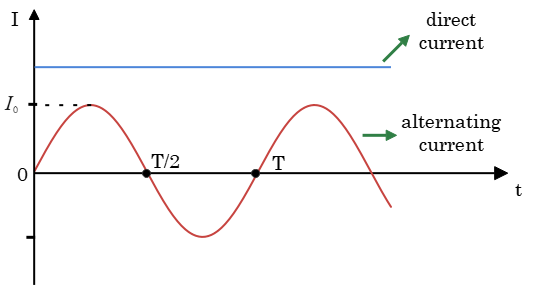In this article learn about the advantages and disadvantages of AC current over DC current. Both types of electric current have their advantages and disadvantages. In 1882, New York City developed the first electric power system.
AC is the short form used for Alternating Current and DC is the short form used for Direct Current. In a circuit direct current flows only in one direction and alternating current flows in both the direction.

Learn more about Alternating current and EMF
AC (alternating current) changes direction periodically, while DC (direct current) flows in only one direction; both are useful in different situations for power generation, transmission, and everyday devices.
What is AC and DC
- In AC, current and voltage vary with time, typically as a sine wave with a period $T$ and frequency $f=1/T$; in DC, current and voltage remain essentially constant with a fixed polarity.
- Household supply is AC because it is easy to generate and transform to different voltages; batteries and most electronics internally use DC for stable operation.
Why AC became standard
- AC voltage can be stepped up or down efficiently with transformers, allowing generation at convenient voltages, high?voltage transmission to cut $I^2R$ losses, and safe distribution at lower voltages.
- These transformer advantages made large?scale AC grids cheaper to build and operate than comparable DC systems in the early power industry debates.
Advantages of AC
- The generation of A.C. is cheaper than that of D.C.
- A.C. machines are simple, robust and do not require much attention for their repairs and maintenance during their use. For example, the transformer necessary to provide alternating current power is quite affordable and involves less maintenance cost.
- A wide range of voltages is obtained by the use of a transformer.
- The magnitude of the current can be reduced by using an inductance or a conductor without any appreciable loss of energy
- A.C. can easily be converted into D.C. with the help of rectifiers.
- When A.C. is supplied at higher voltages in long-distance transmission, the line losses are small compared to a D.C. transmission.
- Efficient electric power transformation over long-distance lines can be achieved through the use of a transformer.
Disadvantages of AC
- The peak value of A.C. is high and it is dangerous to use so better insulation is required.
- It attracts a person who touches it, unlike D.C. which gives a repelling shock.
- An A.C. is transmitted from the surface of the conductor and hence need several strands of thin wires insulated from each other.
Advantages of DC
- Naturally compatible with energy storage (batteries, capacitors) and most electronics, which operate internally on DC rails for stable voltage and noise control.
- For very long underwater/underground links or asynchronous grids, high-voltage DC (HVDC) can reduce reactive losses, avoid skin-effect penalties at high frequencies, and use only two conductors, making point-to-point transmission competitive or superior.
Disadvantages of DC
- Voltage conversion historically required rotating machines or complex electronics, making early wide-area DC systems expensive; modern power electronics have improved this but transformers still make AC voltage conversion simpler in many distribution contexts.
- Traditional three-phase AC networks integrate generation and distribution more easily, so DC often needs converters at interface points with the AC grid, adding cost and control complexity.
Practical takeaways
- Use AC for grid power because transformers let utilities move power efficiently over long distances and deliver safe voltages locally, reducing $I^2R$ loss where $P_{\text{loss}} = I^2 R$.
- Use DC inside gadgets and in storage because steady one?direction flow suits batteries and electronic circuits; rectifiers convert AC from the wall to DC inside chargers and power supplies.
- Safety: never treat either as “safe.” AC shocks tend to be more dangerous at the same voltage; proper insulation, dry hands, and certified protective devices are essential.
Summary table
| Topic | AC (Alternating Current) | DC (Direct Current) |
|---|---|---|
| Direction of flow | Reverses periodically, usually sinusoidal | One direction, steady level |
| Voltage change | Easy with transformers, wide range | Needs converters; modern electronics enable but add cost |
| Long?distance power | Efficient at high voltage with low losses | HVDC competitive for very long links and interconnections |
| Conductor effects | Skin effect raises effective resistance at AC | Uniform current distribution; no skin effect in steady DC |
| Typical uses | Grids, motors, household supply | Batteries, electronics, EV storage, DC links |
| Safety note | Higher shock risk at same nominal voltage | Still dangerous; generally higher let?go threshold |
In the beginning, there was a debate over whether the electrical utility business should be standardised with ac power or dc power.
Due to a number of advantages, alternating current power has surpassed direct current power. The transformation of voltage levels in ac power allows electrical power to be created at low voltage and then step up for transmission over long distances to reduce $I^2R$ losses, and then step down at the distribution end to reduce $I^2R$ losses. This step-up and step-down of voltage is achieved with the help of a transformer.
Hi
what are the advantages of d.c over a.c